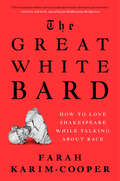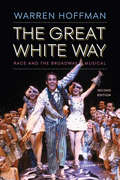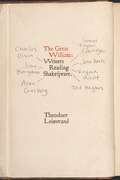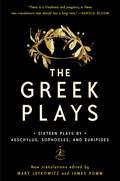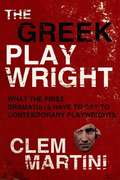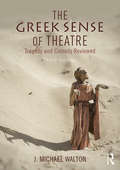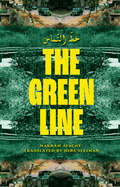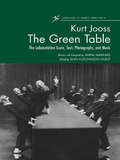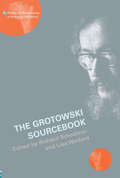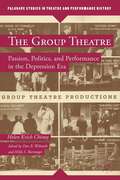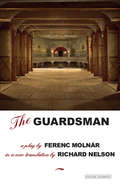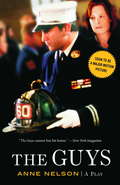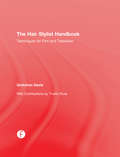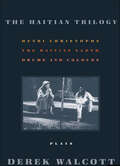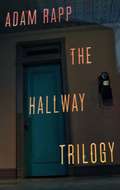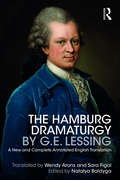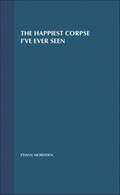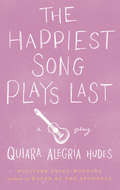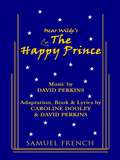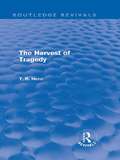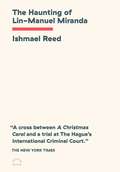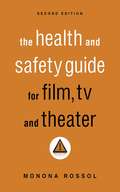- Table View
- List View
The Great White Bard: How to Love Shakespeare While Talking About Race
by Farah Karim-CooperAs we witness monuments of white Western history fall, many are asking how is Shakespeare still relevant? Professor Farah Karim-Cooper has dedicated her career to the Bard, which is why she wants to take the playwright down from his pedestal to unveil a Shakespeare for the twenty-first century. If we persist in reading Shakespeare as representative of only one group, as the very pinnacle of the white Western canon, then he will truly be in peril. Combining piercing analysis of race, gender and otherness in famous plays from Antony and Cleopatra to The Tempest with a radical reappraisal of Elizabethan London, The Great White Bard asks us neither to idealize nor bury Shakespeare but instead to look him in the eye and reckon with the discomforts of his plays, playhouses and society. In inviting new perspectives and interpretations, we may yet prolong and enrich his extraordinary legacy.
The Great White Bard: How to Love Shakespeare While Talking About Race
by Farah Karim-CooperSHAKESPEARE: increasingly irrelevant or lone literary genius of the Western canon?'Powerful and illuminating' James Shapiro, author of 1599: A Year in the Life of William Shakespeare, winner of the Baillie Gifford 'Winner of Winners' 2023 Professor Farah Karim-Cooper grew up loving the Bard, perhaps because Romeo and Juliet felt Pakistani to her. But why was being white as a &‘snowy dove&’ essential to Juliet&’s beauty? Combining piercing analysis of race, gender and otherness in beloved plays from Othello to The Tempest with a radical reappraisal of Elizabethan London, The Great White Bard entreats us neither to idealise nor to fossilise Shakespeare but instead to look him in the eye and reckon with the discomforts of his plays, playhouses and society. If we persist in reading Shakespeare as representative of only one group, as the very pinnacle of the white Western canon, then he will truly be in peril. But if we dare to bring Shakespeare down from his plinth, we might unveil a playwright for the twenty-first century. We might expand and enrich his extraordinary legacy. We might even fall in love with him all over again. *** A TIME MAGAZINE BOOK OF THE YEAR 2023 'Insightful, passionate, piled with facts and has a warm, infectious love for theatre and Shakespeare running through every chapter.' ADRIAN LESTER, CBE 'Dive in and your whole cultural landscape will be refreshed and reframed... A challenging, riveting read, The Great White Bard reminds us how powerful the stories we tell can be on our lives.' ADJOA ANDOH 'Vivid… a thorough analysis but also a kind of love letter… Karim-Cooper sees Shakespeare as holding a mirror to this society, with his plays interrogating live issues around race, identity and the colonial enterprise… Her arguments come to feel essential and should be absorbed by every theatre director, writer, critic, interested in finding new ways into the work.&’ GUARDIAN 'There are plenty of books on Shakespeare: but this one is different. This is Shakespeare as we&’ve (most of us) never been willing to see him – and the works emerge from the analysis as newly complicit, powerful and yet recuperative.' EMMA SMITH, AUTHOR OF PORTABLE MAGIC
The Great White Way: Race and the Broadway Musical
by Warren HoffmanBroadway musicals are one of America’s most beloved art forms and play to millions of people each year. But what do these shows, which are often thought to be just frothy entertainment, really have to say about our country and who we are as a nation? Now in a new second edition, The Great White Way is the first book to reveal the racial politics, content, and subtexts that have haunted musicals for almost one hundred years from Show Boat (1927) to Hamilton (2015). This revised edition includes a new introduction and conclusion, updated chapters, as well as a brand-new chapter that looks at the blockbuster musicals The Book of Mormon and Hamilton. Musicals mirror their time periods and reflect the political and social issues of their day. Warren Hoffman investigates the thematic content of the Broadway musical and considers how musicals work on a structural level, allowing them to simultaneously present and hide their racial agendas in plain view of their audiences. While the musical is informed by the cultural contributions of African Americans and Jewish immigrants, Hoffman argues that ultimately the history of the American musical is the history of white identity in the United States. Presented chronologically, The Great White Way shows how perceptions of race altered over time and how musicals dealt with those changes. Hoffman focuses first on shows leading up to and comprising the Golden Age of Broadway (1927–1960s), then turns his attention to the revivals and nostalgic vehicles that defined the final quarter of the twentieth century. He offers entirely new and surprising takes on shows from the American musical canon—Show Boat (1927), Oklahoma! (1943), Annie Get Your Gun (1946), The Music Man (1957), West Side Story (1957), A Chorus Line (1975), and 42nd Street (1980), among others. In addition to a new chapter on Hamilton and The Book of Mormon, this revised edition brings The Great White Way fully into the twenty-first century with an examination of jukebox musicals and the role of off-Broadway and regional theaters in the development of the American musical. New archival research on the creators who produced and wrote these shows, including Leonard Bernstein, Jerome Robbins, Stephen Sondheim, and Edward Kleban, will have theater fans and scholars rethinking forever how they view this popular American entertainment.
The Great William: Writers Reading Shakespeare
by Theodore LeinwandThe Great William is the first book to explore how seven renowned writers--Samuel Taylor Coleridge, John Keats, Virginia Woolf, Charles Olson, John Berryman, Allen Ginsberg, and Ted Hughes--wrestled with Shakespeare in the very moments when they were reading his work. What emerges is a constellation of remarkable intellectual and emotional encounters. Theodore Leinwand builds impressively detailed accounts of these writers' experiences through their marginalia, lectures, letters, journals, and reading notes. We learn why Woolf associated reading Shakespeare with her brother Thoby, and what Ginsberg meant when referring to the mouth feel of Shakespeare's verse. From Hughes's attempts to find a "skeleton key" to all of Shakespeare's plays to Berryman's tormented efforts to edit King Lear, Leinwand reveals the palpable energy and conviction with which these seven writers engaged with Shakespeare, their moments of utter self-confidence and profound vexation. In uncovering these intense public and private reactions, The Great William connects major writers' hitherto unremarked scenes of reading Shakespeare with our own.
The Greek Plays
by Tony Kushner Ellen MclaughlinFrom The Persians"Defeat is impossibleDefeat is unthinkableWe have always been the favorites of fate.Fortune has cupped usIn her golden palms.It has only been a matterOf choosing our desire. Which fruitTo pick from the nodding tree."This chilling passage is from Ellen McLaughlin's new adaptation of The Persians by Aeschylus, the earliest surviving play in Western literature, an elegy for a fallen civi-lization and a warning to its new conqueror. As Margo Jefferson wrote in the New York Times, "The play is a true classic: we see the present and the future right there, inside the past. And when writers give us a 'new version' (a translation or adaptation) of a classic, they both serve and use it. They serve the playwright's gifts by refusing to simplify. But they can't just imitate. Every age has its own rhythms and drives. The classic must make us feel the new acutely. Ellen McLaughlin serves and uses The Persians with true power and grace."Also included in this volume: Iphigenia and Other Daughters (from Euripides and Sophocles); The Trojan Women (Euripides); Helen (Euripides); and Lysistrata (Aristophanes), all powerfully realized and as relevant today as when they were first performed.Ellen McLaughlin's plays include Days and Nights Within, A Narrow Bed, Infinity's House and Tongue of a Bird, which have been widely produced. She is a past finalist for the Susan Smith Blackburn Prize and was the co-winner of the Great American Play Contest. Also an accomplished actor, Ms. McLaughlin is most known for having originated the part of the Angel in Tony Kushner's Angels in America, appearing in every U.S. production through its Broadway run.
The Greek Plays: Sixteen Plays by Aeschylus, Sophocles, and Euripides
by Sophocles Aeschylus Euripides James Romm Mary LefkowitzThe great plays of Ancient Greece are among the most enduring and important legacies of the Western world. Not only is the influence of Greek drama palpable in everything from Shakespeare to modern television, the insights contained in Greek tragedy have shaped our perceptions of the nature of human life. Poets, philosophers, and politicians have long borrowed and adapted the ideas and language of Greek drama to help them make sense of their own times. <p><p> This exciting curated anthology features a cross section of the most popular—and most widely taught—plays in the Greek canon. Fresh translations into contemporary English breathe new life into the texts while capturing, as faithfully as possible, their original meaning. <p> This outstanding collection also offers short biographies of the playwrights, enlightening and clarifying introductions to the plays, and helpful annotations at the bottom of each page. Appendices by prominent classicists on such topics as “Greek Drama and Politics,” “The Theater of Dionysus,” and “Plato and Aristotle on Tragedy” give the reader a rich contextual background. A detailed time line of the dramas, as well as a list of adaptations of Greek drama to literature, stage, and film from the time of Seneca to the present, helps chart the history of Greek tragedy and illustrate its influence on our culture from the Roman Empire to the present day. <p> With a veritable who’s who of today’s most renowned and distinguished classical translators, The Greek Plays is certain to be the definitive text for years to come.
The Greek Playwright: What the First Dramatists Have To Say To Contemporary Playwrights
by Clem MartiniPicking up where The Blunt Playwright left off, Clem Martini returns to the subject of playwriting, turning his attention to the lessons modern playwrights can learn from the ancient Greeks. Outlining the major playwrights of the era, their major works, and the impact they had on our modern understanding of drama, Martini weaves his direct, informative, and entertaining style through centuries of dramatic evolution to show us exactly what the first dramatists have to say to contemporary playwrights.
The Greek Sense of Theatre: Tragedy and Comedy
by J Michael WaltonIn this updated and extended edition of The Greek Sense of Theatre, scholar and practitioner J.Michael Walton revises and expands his visual approach to the theatre of classical Athens. From the tragedies of Aeschylus, Sophocles and Euripides to the old and new comedies of Aristophanes and Menander, he argues that while Greek drama is seen now as a performance-based rather than a strictly literary medium, more attention should still be paid to the nature of stage image and masked acting as part of this conception.
The Green Line | خطّ التماس
by Makram AyacheA poetic, heartbreaking story of intergenerational queer history in Lebanon, The Green Line weaves together civil war Beirut with a contemporary nightclub, following one family’s journey to discover their past.In the present day, Rami, a twentysomething queer Lebanese Canadian, has returned to the Lebanese mountains to bury his father. To cope with the weight of his grief, Rami, carrying a necklace in the shape of a phoenix left to him by his father, finds himself in a queer Beirut nightclub, where he catches the attention of a powerful drag queen named Fifi, who just so happens to be dressed as a phoenix.In 1978, in the midst of the Lebanese Civil War, Naseeb is attempting to get himself and his sister Mona out of Beirut and into the safety of the mountains. Mona, however, is secretly in love with her classmate, a woman named Yara, and refuses to leave the city. When Naseeb becomes swept up with the descending political culture of the war around him, he creates a rift between himself and Mona greater than the line that divides the country itself.
The Green Table: The Labanotation Score, Text, Photographs, and Music
by Ann Hutchinson Guest* Score, photographs, and production details of one of this century's best-loved ballets * Includes rare archival material * Packaged with audio CD This work brings together the complete dance score of The Green Table--one of the most famous ballets of the 20th century--in Labanotation, along with music notation for the piano accompaniment and a complete recording of the accompaniment on CD. It also includes several essays about the work and its genesis, and many historic production photographs. This book is an important item for all colleges with dance programs to own in their libraries and for scholars interested in the study of contemporary dance.
The Grotesque in Contemporary Anglophone Drama
by Ondřej PilnýGrotesque features have been among the chief characteristics of drama in English since the 1990s. This new book examines the varieties of the grotesque in the work of some of the most original playwrights of the last three decades (including Enda Walsh, Philip Ridley, Tim Crouch and Suzan-Lori Parks), focusing in particular on ethical and political issues that arise from the use of the grotesque.
The Grotowski Sourcebook (Worlds of Performance)
by Richard Schechner Lisa Wolford WylamThis acclaimed volume is the first to provide a comprehensive overview of Jerzy Grotowski's long and multi-faceted career. It is essential reading for anyone interested in Grotowski's life and work.Edited by the two leading experts on Grotowski, the sourcebook features:*essays from the key performance theorists who worked with Grotowski, including Eugenio Barba, Peter Brook, Jan Kott, Eric Bentley, Harold Clurman, and Charles Marowitz*writings which trace every phase of Grotowski's career from his 'theatre of production' to 'objective drama' and 'art as vehicle'*a wide-ranging collection of Grotowski's own writings, plus an interview with his closest collaborator and 'heir', Thomas Richards*an array of photographs documenting Grotowski and his followers in action*a historical-critical study of Grotowski by Richard Schechner.
The Group Theatre
by Milly S. Barranger Helen Krich Chinoy Don B. WilmethThe Group Theatre , a groundbreaking ensemble collective, started the careers of many top American theatre artists of the twentieth century and founded what became known as Method Acting. This book is the definitive history, based on over thirty years of research and interviews by the foremost theatre scholar of the time period, Helen Chinoy.
The Guardsman: A Play
by Richard NelsonThe hilarious and essential new translation of a classic by Tony award-winning playwright Richard Nelson Budapest’s most beautiful young actress is notorious for affairs that only last six months. When she finally marries, she chooses the city’s most handsome and talented young actor. Five and a half months later, suspecting his new wife is getting restless, the actor takes on his most daring role yet—disguising himself as a dashing Emperor’s guardsman—to test her fidelity and win her love. But the more he woos his wife as this guardsman, the more insanely jealous he gets of the character he feels compelled to play. This new translation by Richard Nelson is sharp, funny, and perhaps calls to mind that other psychodrama about a stormy marriage, Who's Afraid of Virgina Woolfe?
The Guys
by Anne NelsonTHE STORY: Less than two weeks after the September 11th attacks, New Yorkers are still in shock. One of them, an editor named Joan, receives an unexpected phone call on behalf of Nick, a fire captain who has lost most of his men in the attack. He's looking for a writer to help him with the eulogies he must present at their memorial services. Nick and Joan spend a long afternoon together, recalling the fallen men through recounting their virtues and their foibles, and fashioning the stories into memorials of words. In the process, Nick and Joan discover the possibilities of friendship in each other and their shared love for the unconquerable spirit of the city. As they make their way through the emotional landscape of grief, they draw on humor, tango, the appreciation of craft in all its forms-and the enduring bonds of common humanity. THE GUYS is based on a true story.
The Hair Stylist Handbook: Techniques for Film and Television
by Gretchen DavisAchieve professional quality hair results with this full-color, comprehensive book from award-winning hair and makeup pros, Gretchen Davis and Yvette Rivas. In The Hair Stylist Handbook: Techniques for Film and Television, you’ll learn how to create that sought-after "complete look" by learning the newest hair techniques that are in demand on film and television sets. Learn how to break into the industry, what products to use to achieve specific effects, how to maintain a look throughout the day, what quick techniques to use to achieve certain textures, and much more. With input from hairstylist Yvette Rivas, this step-by-step guide makes complex techniques clear, allowing you to achieve the most coveted results. In this informative handbook you will find: An extensive chapter on men’s grooming techniques and hair products Specific techniques for dramatic and long lasting hair color Lists of the best hair tools and instructions for how to use them to achieve different looks Information about how production schedules, cast, and crew are all affected and influenced by the hair and makeup team Details on how to run a successful and organized hair and makeup trailer on set Whether you are a professional in the field, or a student looking to break in to the industry, this book will provide you with secrets and information that you cannot find anywhere else.
The Haitian Trilogy: Plays
by Derek WalcottThree plays by the Nobel-laureate Derek Walcott, brought together for the first time in The Haitian TrilogyIn the history plays that comprise The Haitian Trilogy--Henri Christophe, Drums and Colours and The Haytian Earth--Derek Walcott, recipient of the Nobel Prize in Literature, uses verse to tell the story of his native West Indies as a four-hundred-year cycle of war, conquest and rebellion.In Henri Christophe and The Haytian Earth, Walcott re-casts the legacy of Haiti's violent revolutionaries--led by Toussaint L'Ouverture, Jean Jacques Dessalines and Henri Christophe--whose rebellion established the first black state in the Americas, but whose cruelty becomes a parable of racial pride and corruption. Drums and Colours, commissioned in 1958 to celebrate the first parliament in Trinidad, is a grand pageant linking the lives of complex, ambiguous heroes: Columbus and Raleigh; Toussaint; and George William Gordon, a martyr of the constitutional era.From Henri Christophe's high style to the bracing vernacular of The Haytian Earth, to the epic scale and scope of Drums and Colours, in these plays Walcott, one of our most celebrated poets, carved a place in the modern theater for the history of the West Indies, and a sounding room for his own maturing voice.
The Hallway Trilogy
by Adam Rapp"Rapp remains a true man of the theater and a potent writer."--Time Out "To watch The Hallway Trilogy by Adam Rapp is to enter an alternate universe . . . a carnival of the desperate, the grotesque, the outrageous."--The New York Times "I knew in a single sentence that Adam was a writer the world was going to listen to for as long as he felt like writing. . . . Adam writes like nobody else, his fierce poetic power as inescapable as the doom that waits for his characters. The work is bleak and true, his touch that of a master in the making."--Marsha Norman Multi-talented artist and provocateur Adam Rapp shocks and disturbs, weaving themes of love, suffering, and redemption throughout this alarming yet heartening critical examination of societal change. Spanning one hundred years in one Lower East Side tenement hallway, this series of connected plays--Rose, Paraffin, and Nursing--is a dark and compelling exploration of what binds people together and drives them apart. Packed with searing dialogue and harrowing narratives, The Hallway Trilogy "bristles with humor" and "contains some of Rapp's most sensitive and mature writing" (The New York Times). Adam Rapp is a novelist, filmmaker, and an OBIE Award-winning playwright and director. His plays include the Pulitzer Prize finalist Red Light Winter, Nocturne, Stone Cold Dead Serious, Finer Noble Gases, Essential Self-Defense, and more. He is the author of many young adult novels such as Punkzilla, The Buffalo Tree, and Under the Dog, and the writer and director of the film Winter Passing, starring Zooey Deschanel, Will Ferrell, and Ed Harris.
The Hamburg Dramaturgy by G.E. Lessing: A New and Complete Annotated English Translation
by Natalya BaldygaWhile eighteenth-century playwright and critic Gotthold Ephraim Lessing made numerous contributions in his lifetime to the theater, the text that best documents his dynamic and shifting views on dramatic theory is also that which continues to resonate with later generations – the Hamburg Dramaturgy (Hamburgische Dramaturgie, 1767–69). This collection of 104 short essays represents one of the eighteenth century’s most important critical engagements with the theater and its potential to promote humanistic discourse. Lessing’s essays are an immensely erudite, deeply engaged, witty, ironic, and occasionally scathing investigation of European theatrical culture, bolstered by deep analysis of Aristotelian dramatic theory and utopian visions of theater as a vehicle for human connection. This is the first complete English translation of Lessing's text, with extensive annotations that place the work in its historical context. For the first time, English-language readers can trace primary source references and link Lessing’s observations on drama, theory, and performance not only to the plays he discusses, but also to dramatic criticism and acting theory. This volume also includes three introductory essays that situate Lessing’s work both within his historical time period and in terms of his influence on Enlightenment and post-Enlightenment theater and criticism. The newly translated Hamburg Dramaturgy will speak to dramaturgs, directors, and humanities scholars who see theater not only for entertainment, but also for philosophical and political debate.
The Happiest Corpse I've Ever Seen (The History of the Broadway Musical)
by Ethan MorddenFor Ethan Mordden, the closing night of the hit musical, 42nd St. sounded the death knell of the art form of the Broadway musical. After that, big orchestras, real voices, recognizable books and intelligent lyrics went out the window in favor of cats, helicopters, yodeling Frenchmen, and the roof of the Paris Opera. Mordden takes us through the aftermath of the days of the great Broadway musical. From the long-running Cats to Miss Saigon, Phantom, and Les Miserables, to gems like The Producers, he is unsparing in his look at the remains of the day. Not content to scold the shows' creators, Mordden takes on the critics, too, splaying their bodies across the Great White Way like Sweeney Todd giving a close shave. Once more, it's "curtain going up," but Mordden is not applauding.
The Happiest Song Plays Last
by Quiara Alegría Hudes"As ever, Hudes's writing is poetic but wry, full of swagger and poetry. There's live music, but oh, how the lines sing too." - David Cote, Time Out New York"Ms. Hudes draws all her characters with precision and understanding... this warm-blooded play underscores how the disorienting flux of life can be navigated with the help of carefully tended family ties." - Charles Isherwood, New York Times"Delightful... Hudes is a very accomplished storyteller, a playwright with an emergent, fulsome American narrative." - Chris Jones, Chicago TribuneAt the dawn of the Arab Spring in an ancient Jordanian town, an Iraq War veteran struggles to overcome the traumas of combat by taking on an entirely new and unexpected career: an action-film hero. At the same time, halfway around the world in a cozy North Philadelphia kitchen, his cousin takes on a heroic new role of her own: as the heart and soul of her crumbling community, providing hot meals and an open door for the needy.The final installment in Hudes's three-play cycle, which began with Pulitzer Prize-finalist Elliot, A Soldier's Fugue and Pulitzer Prize-winner Water by the Spoonful, The Happiest Song Plays Last is about the search for redemption, humility and one's place in the world.Quiara Alegría Hudes wrote the book for the Broadway musical In the Heights, which received the 2008 Tony Award for Best Musical, a Tony nomination for Best Book of a Musical, and was a Pulitzer Prize finalist. Hudes is on the board of Philadelphia Young Playwrights, which produced her first play in the tenth grade. She now lives in New York with her husband and children.
The Happy Prince
by Caroline Dooley16 principals, chorus / Unit Set / A touching musical based on the well-loved story by Oscar Wilde...the golden statue of the Happy Prince stands high above the city looking down on the misery and poverty beneath him. Desperate to bring hope and happiness to the poor people, he asks a swallow to distribute his gold and jewels to them. The generosity of the Happy Prince and the courage of the swallow help to overcome the greed of the powerful mayor and we are shown that the most precious things in life are often the least obvious.
The Harvest of Tragedy (Routledge Revivals)
by Thomas Rice HennUpon initial publication in 1956, this book was an attempt to re-state certain problems concerning the aesthetics and ethics of the tragic form; to examine these in relation to contemporary work in psychology and anthropology; to enquire into the significance of ‘the fact or experience called tragedy’ in the modern world; and to suggest a synthesis in terms of the Christian tradition. This is a reissue of the corrected second edition of the work, first published in 1966.
The Haunting of Lin-Manuel Miranda
by Ishmael Reed&“That&’s a lot of horse hockey, Hamilton.&” Described by the New York Times as &“classic activist theater&” and &“a cross between &‘A Christmas Carol&’ and a trial at The Hague&’s International Criminal Court.&” "In this, his latest work, the protean Ishmael Reed--the legendary artist and prolific writer--continues to burnish his already sterling reputation by dismantling the 'Creation Myth' of the founding of the U.S., as represented in the incredibly profitable play and musical, Hamilton. Reed, a verbal acrobat of global renown, demonstrates here why he is widely considered to be the leading intellectual in the U.S. today." -Gerald Horne, author of The Counter-Revolution of 1776: Slave Resistance and the Origins of the USA This powerful play, originally produced at the Nuyorican Poets Café, comprehensively dismantles the phenomenon of Lin-Manuel Miranda and Hamilton. Reed uses the musical&’s crimes against history to insist on a radical, cleareyed way of looking at our past and our selves. Both durable and timely, this goes beyond mere corrective – it is a meticulously researched rebuttal, an absorbing drama, and brilliant rallying cry for justice. The perfect tie-in to both the success of and backlash to Hamilton, it is the major voice in contrast to the recent movie. It captures both the earnest engagement that fans of the musical desire, as well as the exhausted disbelief of those who can&’t stand it. Teachers, students and fans of drama, literature, and history will find much to love. It is written by one of America&’s most respected and original writers, who is eagerly promoting it, and who is long overdue for a renaissance.
The Health & Safety Guide for Film, TV & Theater, Second Edition
by Monona RossolThis second edition has been expanded and updated to address new hazards, unique health and safety problems, and particular regulations that threaten anyone working in the entertainment industries today. Artists' advocate Monona Rossol exposes the hazards of theatrical paints, theatrical makeup, pigments, dyes, plastics, solvents, woodworking, welding, asbestos, fog, and offers practical solutions to these dangers. No one working in the performing arts can afford to skip this handbook packed with life-or-death health and safety information.
